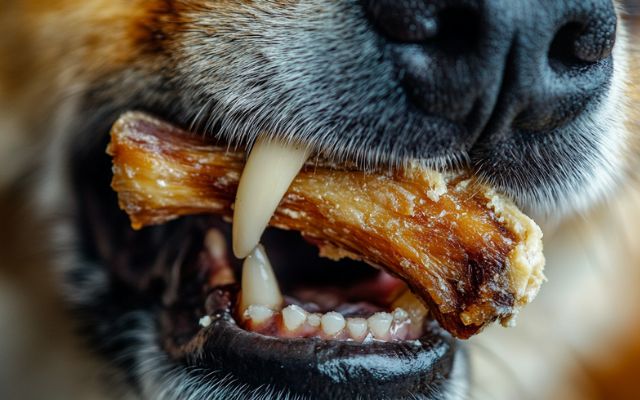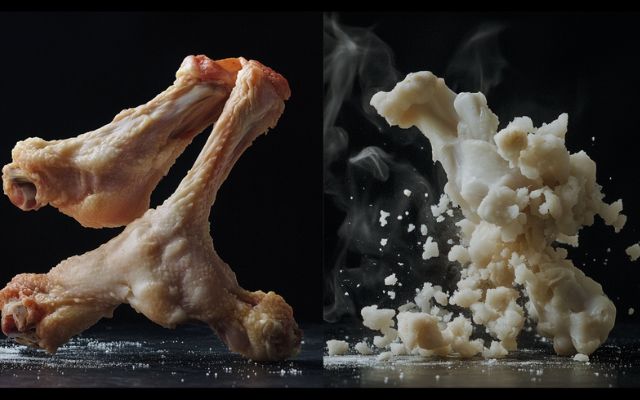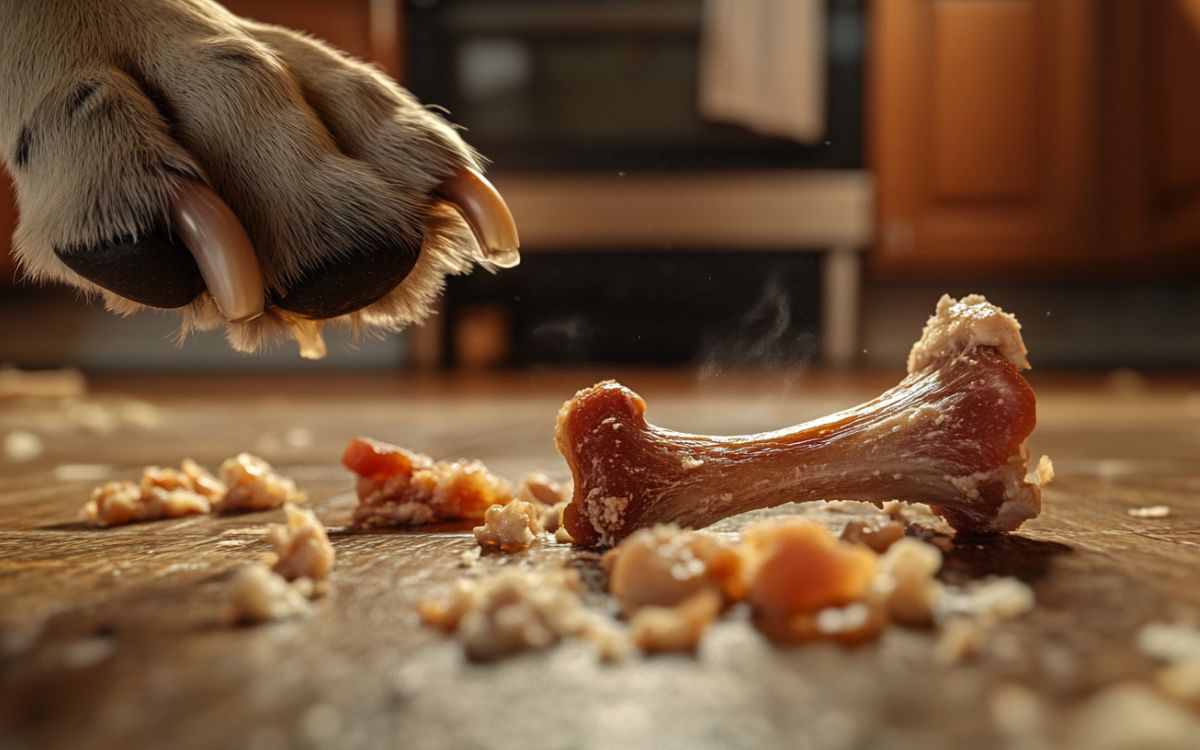Imagine this: Your furry best friend, eyes gleaming with excitement, snags a leftover chicken bone right off your plate. Before you know it, it’s gone! While it might seem like a harmless treat, this could quickly turn into a dangerous situation. Cooked chicken bones are a serious health hazard for dogs.
So, why all the fuss over a simple chicken bone? Because they aren’t built for your pup’s tummy! Unlike raw bones, which have some give, cooked chicken bones turn brittle. They shatter into sharp pieces that can cause chaos inside your dog. From choking to severe internal damage, the risks are too high.

Don’t panic, though! This guide will arm you with everything you need to know:
- The real dangers lurking in that seemingly innocent bone
- Warning signs your dog needs immediate help
- Quick, smart actions to protect your pup
- Prevention tips to keep your home a haven for your furry friend
Whether your dog just gulped down a bone or you want to be prepared, this article has your back. Let’s dive into how to keep your dog safe and sound!
The Hidden Dangers of Chicken Bones
Think your dog’s love for gnawing means chicken bones are fair game? Think again! While pups have a natural urge to chew, not all bones are safe. In fact, cooked chicken bones are a whole different beast altogether.
Cooked vs. Raw: A Recipe for Disaster
The difference between raw and cooked bones is like night and day. Raw bones are relatively soft and pliable, bending under pressure. But toss them in the oven or frying pan, and they undergo a dangerous transformation. Cooked chicken bones become brittle and hard, snapping into razor-sharp shards that can wreak havoc on your furry friend’s insides.

Anatomy of a Doggone Disaster
Picture this: your pup happily gulps down a chicken wing, but instead of a satisfying crunch, those cooked bones splinter into sharp fragments. These jagged edges act like tiny knives, slicing and dicing their way through your dog’s delicate digestive system.
- Mouth and Throat: The first stop on this dangerous journey, where bones can lodge in the gums, tongue, or throat, causing pain and potential choking.
- Esophagus: The tube connecting the mouth to the stomach, vulnerable to punctures and tears from those sharp edges.
- Stomach and Intestines: Once in the belly, bone shards can continue their rampage, potentially piercing the stomach lining or intestines. This can lead to serious infections, blockages, and even life-threatening peritonitis (inflammation of the abdominal lining).
Size Doesn’t Always Matter (Even for “Soft” Bones)
You might think, “My dog only ate a small piece, so it’s no big deal, right?” Wrong! Even tiny bone fragments can cause big problems, especially in small breeds. And those seemingly soft bones your pup loves? They harden up surprisingly fast once chewed and swallowed.
Think of cooked chicken bones as tiny ticking time bombs inside your dog’s belly. The faster you act, the better the chances of defusing the situation before it explodes into a full-blown medical emergency.
Recognizing the Emergency: Your Dog Ate a Chicken Bone, Now What?!
Heart pounding, you just witnessed your furry friend gobble down a forbidden chicken bone. Don’t panic! While it’s a serious situation, staying calm is key to helping your pup. Here’s how to tell if your dog needs immediate attention:
Choking: Every Second Counts!
If your dog is choking, you need to act fast. Here are the telltale signs:
Pawing at their mouth: They might be trying to dislodge the bone.
Gasping, wheezing, or struggling to breathe: A clear sign of a blocked airway.
Pale or blue gums: This indicates a lack of oxygen – a major red flag!
If you spot any of these, don’t hesitate! If you know how, perform the Heimlich maneuver for dogs. If not, or if the choking persists, rush your dog to the nearest emergency vet clinic immediately.
Distressed, But Not Choking?
Even if your dog isn’t choking, other signs warrant a vet visit ASAP:
- Gagging or retching: The bone could be stuck in the esophagus.
- Drooling like a faucet: This is often a sign of pain or discomfort.
- Vomiting: Especially if it’s bloody or looks like coffee grounds (digested blood).
- Diarrhea: This could be bloody or contain bone fragments.
- Acting “off”: Lethargy, weakness, whining, pacing – these are all signs that something’s wrong.
- Loss of appetite: If your pup suddenly refuses food or water, it’s a red flag.
Remember, these are just a few warning signs. Trust your gut. If your dog acts unusual in any way after eating a chicken bone, contact your vet immediately.

The Silent Threat: Delayed Reactions
Don’t be fooled if your dog seems fine at first. Sometimes, the damage from a chicken bone isn’t immediately obvious. It can take hours or even days for complications to arise. So, even if your pup seems normal after the bone incident, call your vet for advice.
Know Your Pup’s Risks: Breed-Specific Concerns
Some breeds are more prone to chicken bone troubles. Brachycephalic breeds (think Bulldogs, Pugs) with their flat faces are at higher risk of choking. Tiny toy breeds are more likely to get blockages, even from small bone pieces. If your dog falls into either category, be extra cautious and contact your vet right away if they swallow a bone.
Remember, when it comes to chicken bones, it’s always better to be safe than sorry.
Your Action Plan: From Panic to Peace of Mind
Your dog just scarfed down a chicken bone – cue the panic! But take a deep breath, because a cool head is your best tool in this situation. Here’s your game plan to get from “Oh no!” to “Phew, we’re okay”:
First Steps at Home: Think Fast, Act Smart
- Secure the scene: Any leftover bones? Get ’em outta there! Make a mental snapshot of the type and size of bone your dog swallowed – this intel will be gold for your vet.
- Resist the urge to gag: Unless your vet tells you otherwise, don’t try to make your dog throw up. It sounds counterintuitive, but forcing the bone back up could cause even more damage, like tearing the esophagus.
- Gather intel: Before you dial the vet, grab these crucial details:
- Your dog’s stats: Breed, age, weight – it all matters for risk assessment.
- The bone intel: Was it a drumstick, a wing, a tiny sliver? The more details, the better.
- Time of the crime: When did the bone bandit strike? The sooner you act, the better the outcome.
- Health history: Any underlying conditions your vet should know about?
Phone a Vet: Your Dog’s Best Friend (Besides You, of course!)
This is non-negotiable, even if your pup seems perfectly fine. Call your veterinarian or, if it’s after hours, an emergency animal clinic. Be prepared to provide the information you gathered in the previous step. The vet will assess the situation and advise you on the best course of action.
If you’re unsure whether your dog’s situation is urgent, you can also contact the Pet Poison Helpline, which provides 24/7 assistance and advice for potential poisonings in pets, including those caused by ingesting foreign objects like chicken bones.
Pro Tip: Keep the contact information for your regular veterinarian, a 24/7 emergency animal clinic, and the Pet Poison Helpline readily available. You never know when you might need them!
At the Vet: Your Dog’s in Good Hands
Depending on the situation, your vet might recommend:
- X-rays: To see where that bone is hiding and if it’s causing any trouble.
- Endoscopy: A tiny camera to take a peek inside and maybe even snatch the bone back out.
- Surgery: The last resort, if the bone’s causing a blockage or major damage.
Don’t worry, your vet will explain everything and help you decide the best plan for your pup. To know more about when your dog needs a vet checkup, consult our article: When to Take Your Dog to the Vet: A Complete Guide.
Home Sweet Home: After-Vet TLC
If your dog gets the all-clear to go home, your vet will give you a recovery plan. This usually involves:
- Bland diet: Think boiled chicken and rice – easy on the tummy.
- Poop patrol: Keep an eagle eye on your dog’s stool for any bone fragments.
- Symptom watch: If your dog acts out of sorts, call your vet right away.
Remember, follow your vet’s orders to the letter, and don’t hesitate to ask questions. With prompt action and a little TLC, your furry friend will likely bounce back from this bone-headed escapade in no time!
Prevention is Key: Outsmarting Your Bone-Loving Bandit
Congratulations! You’ve weathered the chicken bone storm. But let’s not roll those dice again, shall we? With a few simple tweaks to your routine, you can drastically reduce the risk of your dog ever encountering – much less devouring – those dangerous bones. It’s time to level up your pup-proofing game!
Trash Talk: Make Your Garbage Can Fort Knox
Let’s be honest, our furry friends are masters of sniffing out culinary treasures in the trash. But a rummage through the bin can turn deadly if it contains a hidden chicken bone. Here’s how to outsmart your four-legged trash panda:
- Upgrade to Fort Knox: Ditch the flimsy trash can and invest in a sturdy one with a locking lid. Think bear-proof, but for dogs.
- Chill Out Those Scraps: Before you toss those tempting bones, give them a quick trip to the freezer. The cold will reduce the enticing aroma and make the bones harder to break apart if your sneaky pup gets in.
- Double Bag It: Treat those bones like confidential documents. Wrap them in newspaper or plastic wrap, then seal them in a sturdy bag before tossing them in the bin.
- Create a “No-Dog Zone”: If possible, keep your trash can in a designated area your dog can’t access – a pantry, a closed-off laundry room, or even a cabinet with a childproof lock. It’s like a secret hideout, but for your garbage.

Train Your Dog: The Jedi Mind Trick of “Leave It” and “Drop It”
Teaching your dog commands like “leave it” and “drop it” is like giving them a superpower against temptation. With consistent practice, your pup will learn to resist even the most alluring chicken bone and release it on command.
Take it up a notch: Train your counter-surfing ninja to stay off tables and counters, the prime real estate for unguarded chicken bones. And if your dog’s a professional beggar, redirect their attention with a designated spot or a chew toy during mealtimes.
Bone Appetit? Safe and Satisfying Chews for Your Pup
We get it – dogs love to chew. It’s good for their teeth and keeps them entertained. But instead of risky chicken bones, offer them a buffet of safe and delicious alternatives:
- Raw Bones (Just for Dogs!): These are typically softer and less likely to splinter than cooked bones. Choose the right size for your dog to prevent choking – think bigger than their snout.
- Dental Chews: These come in all shapes, sizes, and flavors to keep your pup’s chompers clean and their mind engaged. Look for durable options that won’t easily break apart.
- Bully Sticks: These long-lasting chews are a fan favorite, but always supervise your dog to ensure they don’t bite off large chunks.
- Chew Toys Galore: The options are endless! From rubber bones to squeaky toys, choose ones that match your dog’s size and chewing style.
Spread the Word: Be a Bone Safety Ambassador
Your experience is valuable! Share your knowledge with other dog owners at the park, pet store, or online. By spreading awareness about the dangers of chicken bones, you could save another pup from a painful ordeal. Remember, a little prevention goes a long way in keeping those tails wagging!
Conclusion: The Last Word on Chicken Bones (But Hopefully Not Your Dog’s Last Meal!)
Phew! We’ve covered a lot of ground, haven’t we? From bone-shattering dangers to vet visits and poop patrols, it’s been a wild ride. But remember, the most important takeaway is this: Cooked chicken bones are a no-go zone for your furry friend. Seriously, they’re about as welcome in your dog’s belly as a skunk at a garden party.
But fear not! Armed with this newfound knowledge, you’re now a bone-savvy superhero, ready to swoop in and save the day (or at least your dog’s dinner). And above all, trust your instincts. If you’re worried about your dog, don’t hesitate to reach out to your vet. After all, you know your furry friend best.
Now go forth, armed with this knowledge, and keep those tails wagging! And remember, a little prevention today can save you a whole lot of heartache (and vet bills) tomorrow.
P.S. Have any bone-chilling stories to share? Questions about keeping your pup safe? Drop a comment below – let’s create a community of bone-aware dog lovers!
FAQ: Your Burning Questions About Dogs and Chicken Bones, Answered!
- Help! My dog just ate a chicken bone, but they seem fine. Should I panic? Breathe. While it’s a scary situation, don’t freak out just yet. But don’t ignore it either! Call your vet right away, even if your pup seems perfectly normal. Chicken bones can cause hidden damage, and your vet can assess the risk and guide you on what to do next.
- Are all chicken bones off-limits for my dog, or can they have some types? Cooked chicken bones are the enemy! They become brittle and splinter easily, causing serious trouble inside your pup’s tummy. Raw bones (from a reputable source and the right size) are a safer option, but always supervise your dog while they chew.
- Uh oh, my dog ate a chicken bone a few days ago, and now they’re vomiting or have diarrhea. Is this bad? Yes, it’s bad news. Delayed symptoms like these could mean internal damage or a blockage. Don’t wait! Get your furry friend to the vet ASAP. Time is of the essence in this situation.
- My dog’s a big guy – can a tiny chicken bone really hurt them? Size doesn’t always matter when it comes to chicken bones. Even small fragments can cause irritation, blockages, or even punctures in your dog’s digestive system. Play it safe and check with your vet, no matter your dog’s size.
- Are there other cooked bones besides chicken that I should avoid giving my dog? You bet! Cooked bones from any animal are a no-no. The cooking process turns them into dangerous splinters. This includes turkey, pork, beef, or fish bones. Stick to raw bones (with supervision) or dog-approved chews to keep those tails wagging!

Healthy dogs mean happy dogs, and that makes me happy! I’m here to share all the tips for keeping your best furry friend in top shape, from puppyhood to their golden years.

